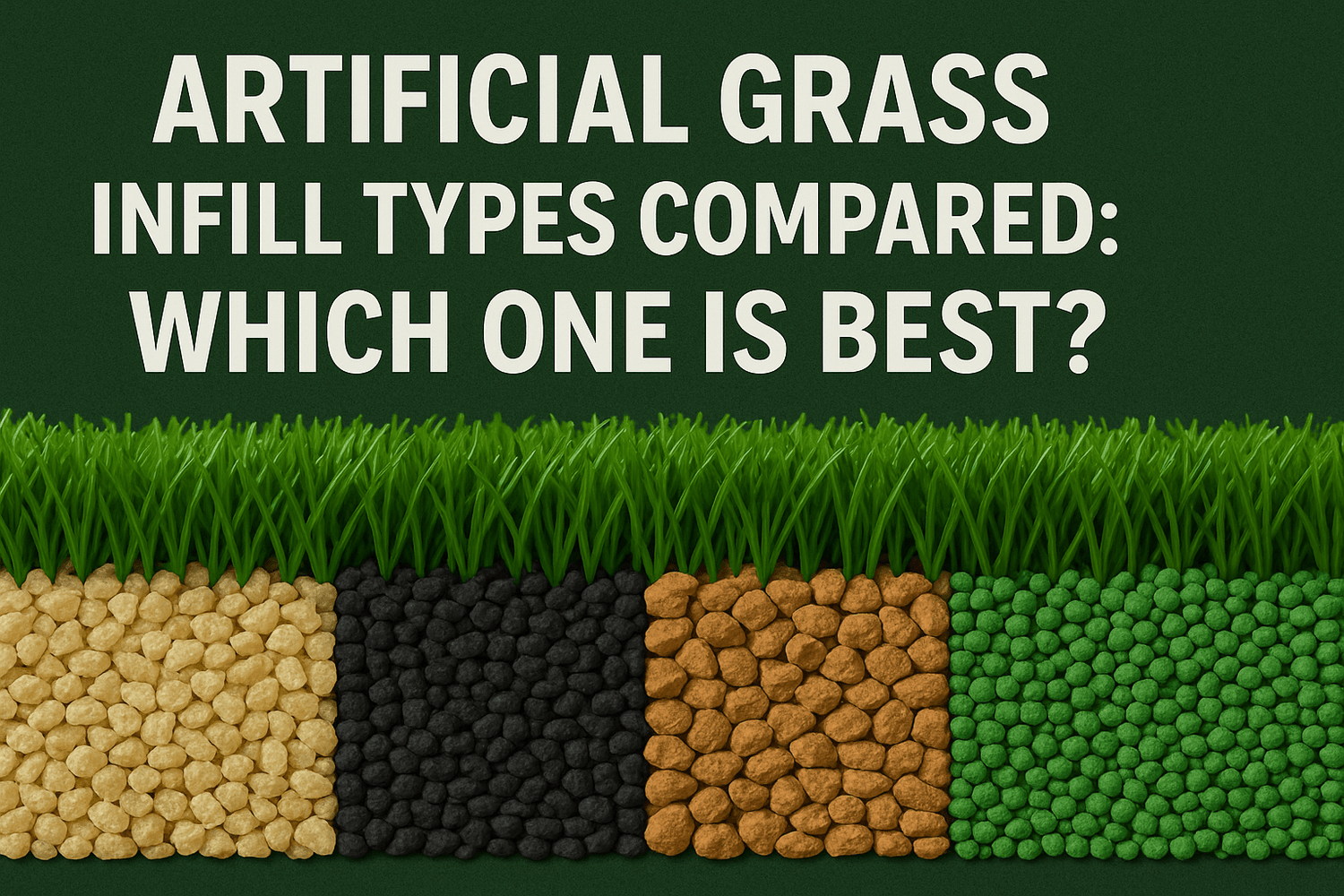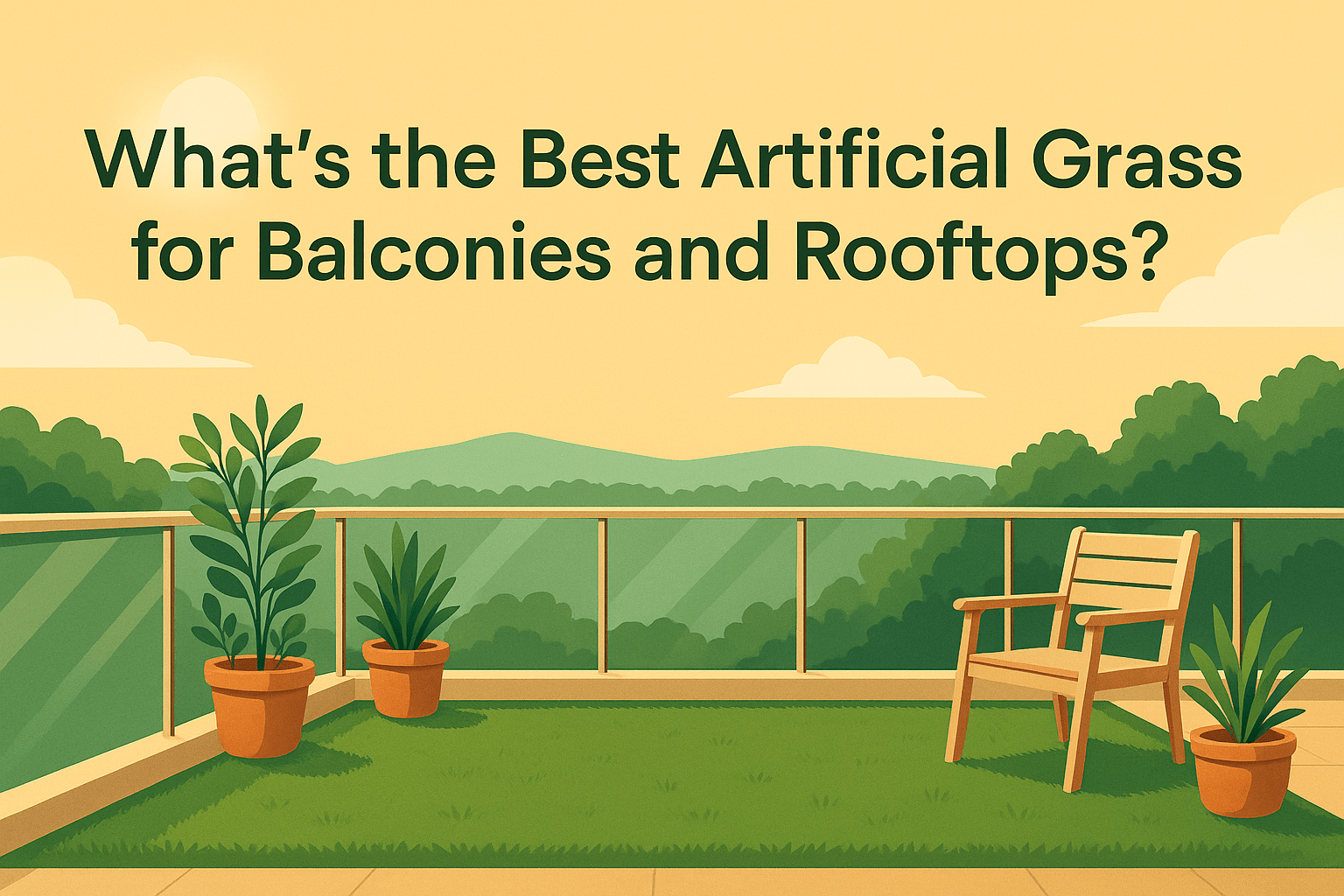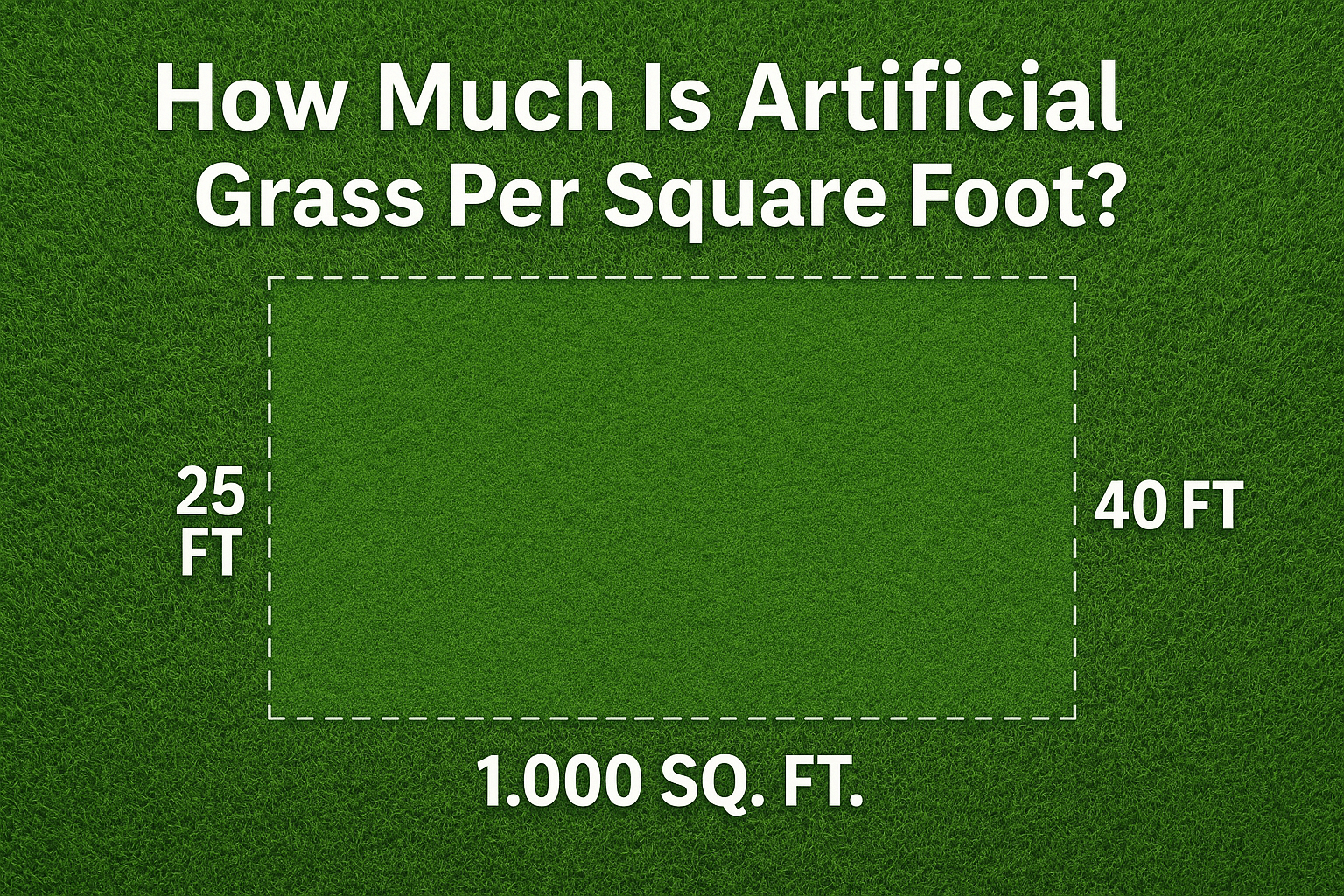Artificial grass infill types are not all the same. Each one plays a big role in how your turf performs, looks, and holds up over time.
Infill is the loose material placed between the blades of synthetic grass. It helps keep the turf flat, supports the fibers, and adds weight to prevent movement.
More than just a filler, infill also improves drainage, softens the surface, and protects the turf’s backing from damage. Without it, artificial grass flattens fast.
This guide will help you understand the artificial grass infill and decide which type fits your space best.
What Is Artificial Grass Infill and Why It Matters
Artificial grass infill is a loose material added between the blades of turf after installation. It helps the grass look and feel natural.
Infill supports the turf fibers. It keeps them upright and prevents them from laying flat under weight or pressure. Without infill, turf quickly looks worn out.
It also acts as a cushion. This makes walking or playing on synthetic turf feel softer and more comfortable. Some infills offer better shock absorption than others.
Infill helps drainage too. Rainwater or rinsing water moves through the infill and drains through the turf backing into the ground.
The added weight from infill keeps the turf in place. It prevents wrinkles, lifting, or movement from wind, foot traffic, or weather changes.
Core Benefits of Using the Right Infill
The right infill keeps artificial grass stable. It holds the turf down and stops it from shifting, folding, or wrinkling over time.
It supports the turf blades, helping them stay upright. This keeps the lawn looking fresh, clean, and full.
Some infills absorb impact better. This is helpful for playgrounds, sports fields, and backyards with kids or pets.
Good infill improves drainage. It lets rainwater or cleaning water flow through the turf easily, preventing puddles and moisture buildup.
Certain infills also help control pet odors. Zeofill and Durafill, for example, can trap smells and reduce bacterial growth.
Choosing the right infill protects the turf’s backing. It adds a buffer between the surface and daily wear, helping the turf last longer.
Artificial Grass Infill Types Overview
This table shows the most common artificial grass infill types. Each option has different strengths and weaknesses. Use this to compare them easily.
|
Infill Type |
Material |
Best For |
Main Benefit |
Known Issues |
Cooling Effect |
|
Silica Sand |
Crushed Quartz |
Lawns with low foot traffic |
Cheap and stable |
Hardens over time, traps pet odors |
Low |
|
Crumb Rubber |
Recycled Tires |
Sports Fields |
Great shock absorption |
Gets hot, not pet friendly |
Very Low |
|
Zeofill |
Volcanic Mineral |
Pet Turf, Rainy Areas |
Odor Control |
Can clump, needs mixing |
Moderate |
|
Durafill / Envirofill |
Acrylic-Coated Sand |
High-use Areas, Pets |
Antimicrobial, long-lasting |
Expensive |
Medium |
|
Greenplay |
Coconut Fibers , Cork |
Playgrounds, Humid Climates |
Natural Cooling |
May need upkeep |
High |
|
Walnut Shell |
Ground Shells |
Warm Climates, Lawns |
Lightweight, eco-safe |
Harder to clean |
High |
|
Hydrochill |
Coated Silica Sand |
Hot Regions |
Best cooling when wet |
Needs water to activate |
Very High |
Detailed Comparison of Popular Infill Options
Silica Sand
Silica sand is a common infill. It works best in areas with low foot traffic like front yards or decorative lawns. It helps the turf stay upright and drains well.
It is cheap and easy to install. But it has no antimicrobial properties, and it may trap pet odors. It can also harden over time and lose drainage ability.
Crumb Rubber
Crumb rubber is made from recycled rubber like old tires. It gives strong shock absorption, which makes it good for sports fields and play areas.
It helps protect players during falls. But it gets hot in the sun. It can trap smells and leave black dust on clothes or shoes.
Zeofill
Zeofill is a mineral infill made from Zeolite granules. It absorbs and locks in pet odors like urine. The smell is only released when it rains and drains out.
It is popular for pet turf. It also keeps turf cooler than rubber. But it is light, so it works best when layered under heavier infill.
Durafill / Envirofill
Durafill, also known as Envirofill infill, is coated sand with antimicrobial properties. It prevents bacterial growth and stays cleaner.
It is rounder than silica sand, which makes it softer. It works well in high-use areas and around kids and pets. It costs more but lasts longer.
Greenplay (Corkonut)
Greenplay infill is a mix of coconut fibers and cork. It is all-natural and cools the turf using the evaporative cycle. It works best in humid or rainy climates.
It is safe for kids and feels soft underfoot. It may need more care in wet areas, but it stays cool in hot sun.
Walnut Shell
Walnut shells are another organic infill option. They help reduce heat and offer a soft feel. They are good for residential lawns in hot, dry areas.
They cost more and may be harder to clean. But they are lightweight and need less material than sand.
Hydrochill
Hydrochill is a silica-coated sand with cooling features. It needs water to work. Once wet, it cools turf for hours through evaporation.
It is best for synthetic lawns in very hot areas. It costs more and may feel slippery when wet. It is not ideal for sports fields.
Cost and Temperature Performance of Common Infill Types
|
Infill Type |
Estimated Cost (Per Sq. Ft.) |
Dry Surface Temp (°F) |
Temp After Watering (°F) |
Notes |
|
LITA Coated Silica Sand |
$1.60 – $5.70 |
~145 |
~120 |
Silica-free, pet-safe, coated for odor/drainage control |
|
Zeofill |
$1.00 – $2.00 |
151 |
125 |
Controls odor, porous for drainage |
|
Durafill / Envirofill |
$0.90 – $1.80 |
153 |
129 |
Coated acrylic, antimicrobial, low dust |
|
Hydrochill |
$1.00 – $2.00 |
145 |
114 |
Heat-reducing, requires watering |
|
Greenplay (Corkonut) |
$1.50 – $2.50 |
~145 |
~120 |
Organic, cooler, biodegradable |
|
Crumb Rubber |
$0.75 – $1.25 |
162 |
143 |
Impact absorbent, not ideal for pets or hot climates |
Notes:
- LITA’s price is based on $80 per 50-lb bag, covering ~14–50 sq. ft depending on turf height.
- Temperature values are averages based on lab and field tests and may vary by region and sun exposure.
- LITA’s coated sand stands out for odor resistance, safety, and drainage, which justifies the higher cost.
Best Infill Type for Each Use Case
For Pets
Use Zeofill with a base layer of Durafill. This combo helps trap pet odors, drains well, and stays cleaner over time.
For Children and Playgrounds
Greenplay or Durafill are safe choices. Both feel soft and offer good shock absorption. Greenplay also keeps the turf cooler.
For Sports Fields
Choose Crumb Rubber or EPDM Rubber. These infills reduce impact and help protect players during falls or quick moves.
For Lawns and Aesthetic Spaces
Silica Sand or Walnut Shell infills work well. They hold turf in place and look natural. Best for residential lawns with low use.
For Hot Climates
Use Hydrochill or Greenplay. Both reduce heat absorption and lower the temperature of turf during hot weather.
Best Practices for Infill Maintenance
Infill needs care to work well and last long. Without maintenance, turf can flatten, shift, or trap smells.
Clean the surface weekly. Remove leaves, dirt, and waste. This keeps the area safe and fresh.
Rinse the turf with water often, especially in dry weather. This helps prevent buildup of dust and bacteria.
Use a power broom once a year. This lifts the turf fibers and spreads the infill evenly again.
Add more infill every 12 months. Over time, it settles or gets removed by rain, play, or pets.
For pet turf, check for bacterial growth. Choose antimicrobial infill and clean with water and mild soap if needed.
Mixing infill types can improve performance. For example, use silica sand below and Zeofill on top.
Why LITA’s Infill Works Well with Their Turf
LITA understands that good turf starts from the ground up. Their artificial grass is designed to pair seamlessly with infill like coated silica sand. This choice isn’t marketing fluff—it’s a functional design.
Their green-coated silica sand resists compaction and improves drainage. As LITA explains, it is hydrophobic and non-silica, so water and pet waste flow down, not stay on the surface. This helps turf stay dry and hygienic with minimal upkeep.
Because LITA turf has perforated backing, infill settles evenly and stays where it should. That even support helps the turf fibers stay upright and protects the backing layer under pressure.
Their coated sand is also pet-friendly. It gives weight to the grass to prevent movement, while the coating makes it easier to hose off and less likely to trap odors. It’s a functional match—no sales pitch, just thoughtful pairing of turf and infill.
Conclusion: Which Artificial Grass Infill Type Is Best?
There is no single best infill for all uses. Each type works better for different goals, climates, and turf areas.
If you need odor control for pets, choose Zeofill. For cooler turf in hot zones, go with Hydrochill or Greenplay.
Durafill is great if you want something safe, long-lasting, and low in maintenance. Crumb rubber fits sports fields because of its strong shock absorption.
Silica sand is the lowest-cost option, but it’s best for low-traffic areas. For eco-conscious users, walnut shells or cork infill offer natural cooling and comfort.
Explore LITA’s turf and infill options to find the right match for your space. Visit their site for detailed product specs and installation tips.



Leave a comment
This site is protected by hCaptcha and the hCaptcha Privacy Policy and Terms of Service apply.